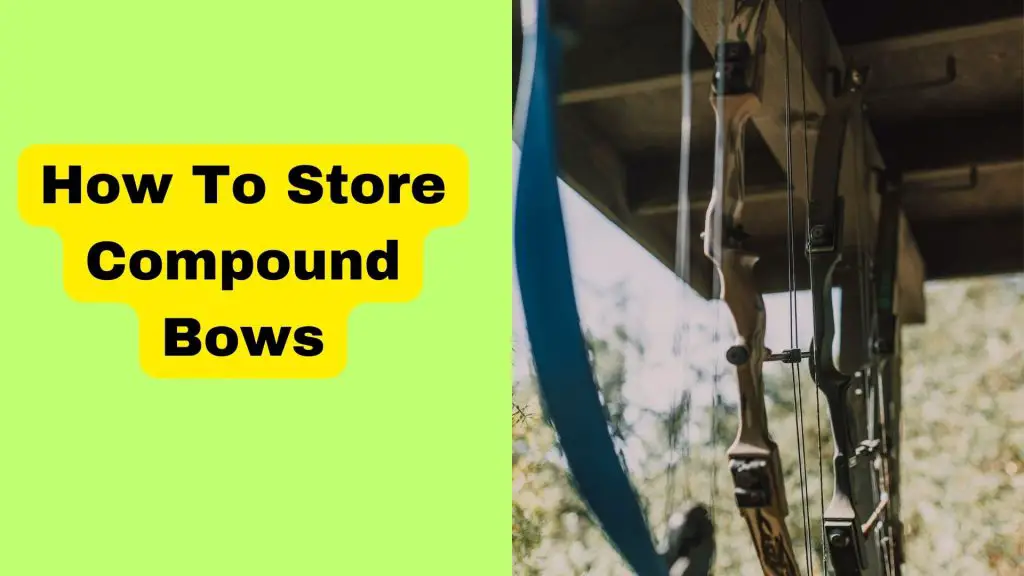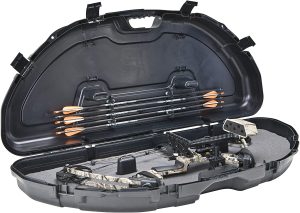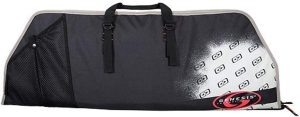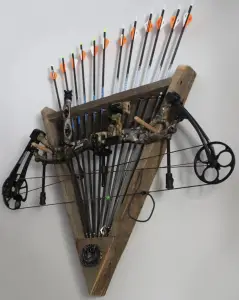The Ultimate Guide to Storing Your Compound Bow: Equipment and Tips!
As a compound bow owner, you know that investing in the right equipment is essential to ensure your bow’s longevity and maintain its peak performance.

One critical aspect of owning a compound bow is knowing how to store it properly. Without proper storage, your bow can be susceptible to damage and wear and tear over time.
Are you unsure about the best ways to store your compound bow?
In this article, we’ll discuss the different types of storage equipment available, such as hard cases, soft cases, and wall-mounted racks.
We’ll also provide tips on how to choose the right type of storage equipment for your needs and a step-by-step guide on how to store your compound bow properly.
So, whether you’re a beginner or a seasoned archer, keep reading to learn more about the best ways to store your compound bow and keep it in top condition.
Understanding Compound Bows
Before discussing how to store them properly, it’s important to have a good understanding of what a compound bow is and its various components.
What a Compound bow Is
A compound bow is a modern bow that uses a system of pulleys and cables to generate a significant amount of kinetic energy, allowing arrows to be shot at high speeds and with great precision.
Unlike traditional bows, which rely on the strength and skill of the archer, a compound bow allows the archer to hold the bow steady for a longer period, increasing accuracy and reducing fatigue.
Different Parts of a Compound Bow In Brief
- Riser: The riser is the central part of the bow where the grip is located. It is usually made of aluminum, magnesium, or carbon fiber, and it provides a solid foundation for attaching the limbs and other accessories.
- Limbs: The limbs are the two long, flexible components of the bow that store the energy generated by the archer’s draw. They are usually made of fiberglass or carbon fiber, and they are attached to the riser via limb pockets.
- Cams: The cams are the circular components at the end of each limb. They are responsible for controlling the draw weight and length of the bowstring.
- Bowstring: The bowstring is the main component that transfers the energy from the bow to the arrow. It is usually made of high-strength synthetic materials, such as Kevlar or Dacron.
- Cable guard: The cable guard is a metal rod that keeps the bowstring from rubbing against the cables during the shot.
- Peep sight: The peep sight is a small ring attached to the bowstring that helps the archer aim the bow accurately.
- Stabilizer: The stabilizer is a rod that is attached to the front of the bow to reduce the amount of movement and vibration during the shot.
Compound bows can be customized with a wide range of accessories, including sights, arrow rests, quivers, stabilizers, and more. These accessories can help to improve accuracy, reduce noise and vibration, and enhance overall performance.
Why Proper Storage Is Important For A Compound Bow
Proper storage is essential for any piece of equipment, and compound bows are no exception.
Failing to store your compound bow properly can result in damage that can affect its performance and even its longevity.
Improper storage of a compound bow can lead to a variety of issues, including:
- String and cable damage: Bowstrings and cables can become frayed or damaged if they are not stored correctly. This can lead to a loss of accuracy, as well as reduced draw weight and velocity.
- Limb damage: If the limbs of a compound bow are bent or damaged, they can lose their power and accuracy. This can happen if the bow is stored in a position where it is exposed to pressure or stress.
- Rust and corrosion: If a compound bow is exposed to moisture or humidity, it can rust and corrode over time. This can cause irreparable damage to the bow’s components and affect its performance.
Effects of temperature, humidity, and other environmental factors on a compound bow
Environmental factors can have a significant impact on the condition of a compound bow.
- Temperature and humidity are two of the most important factors to consider when storing a bow.
- Excessive heat or cold can cause the limbs of the bow to warp or become brittle, while high humidity can cause rust and corrosion.
- Exposure to sunlight can also cause the bowstring to become brittle and weaken over time.
- In addition to these factors, other environmental factors such as dust, dirt, and moisture can also cause damage to the bow if it is not stored properly.
Importance of Protecting the Bowstring and Limbs
The bowstring and limbs are two of the most important components of a compound bow, and they require special attention when it comes to storage.
To protect the bowstring, it is recommended to use a bowstring wax or oil, which helps to prevent fraying and breakage. It is also important to avoid storing the bowstring in a position where it is under tension, as this can cause it to stretch and weaken over time.
To protect the limbs, it is important to store the bow in a position where they are not under any pressure or stress. This means avoiding placing heavy objects on top of the bow or storing it in a position where it is bent or twisted.
Additionally, it is recommended to store the bow in a case or cover to protect it from dust, dirt, and moisture.
Equipment for Storing Compound Bows
There are several options available on the market, including hard cases, soft cases, and wall-mounted racks.
In this section, we will discuss the benefits and drawbacks of each type of storage equipment and provide tips on how to choose the right type for your needs.
Hard Cases
Hard cases are the most popular type of storage equipment for compound bows.
They are made of durable materials such as plastic or aluminum, which provide excellent protection for your bow.
Some hard cases are also designed with foam padding to prevent the bow from moving around during transport.
Benefits:
- Maximum protection for your bow
- Durable and long-lasting
- Often come with additional storage space for accessories
Drawbacks:
- More expensive than soft cases
- Can be bulky and heavy
A hard case is considered the optimal option for providing maximum protection for your compound bow. These cases are designed to safeguard all of your archery gear and are built to withstand the wear and tear of travel.
One good case is the Plano Protector Compound Bow Case.

The case offers lockable, padded protection for single and split or parallel-limb bows. Its patented Pillarlock technology provides added anti-crush strength and rigidity, while poly tie-downs hold the bow in place during travel.
The case also features thick-wall construction and high-density poly foam to keep the bow aligned. The case also includes interior storage for five arrows, a ribbed carry handle, and two strong latches.
The hard case fits most modern-style compound bows and is made in the USA so you don’t have to worry about the quality.
- PLANO PROTECTOR COMPOUND BOW CASE: Lockable, padded protection for single and split or parallel-limb bows with or...
- PATENTED PILLARLOCK provides added anti-crush strength and rigidity. Poly tie-downs hold your bow in place to protect...
- KEEP SHOTS ON TARGET: This hard bow case features thick-wall construction and high-density poly foam to keep the bow...
Other Popular Bow Cases Are
1. SKB Cases iSeries-Military Grade Standards, Lifetime Warranty and $1,500 in coverage, corrosion and impact resistant, water and dust tight, separate quiver, arrow, and accessory box compartments
However, they are at a premium Price.
2. Case Club Parallel Limb Compound Bow Pre-Cut Case: Waterproof, Hydro Absorbent Silica Gel Canister that helps prevent rust, Crushproof design.
This particular case is a great mid-to-high-level option for anyone that wants to try something new.
Soft Cases

Soft cases are an affordable and lightweight option for storing your compound bow.
They are made of materials such as nylon or canvas and provide a moderate level of protection for your bow. Soft cases often come with adjustable straps or handles for easy transportation.
Benefits:
- Affordable and lightweight
- Easy to transport
- Often come with additional storage space for accessories
Drawbacks:
- Limited protection for your bow
- Not as durable as hard cases
- Can wear out over time with frequent use
We recommend a soft case such as Easton Genesis 4014 Bow Case.
The case is made of durable Poly fabric, which is known for its strength and resistance to wear and tear.
It features integrated arrow tote attachment straps that provide secure storage for your arrows during transport, and a mesh accessory pocket that allows you to keep your bow accessories organized and easily accessible.
- Custom tailored for genesis compound Bow
- Features integrated arrow tote attachment straps and mesh accessory pocket
- Fabric Type:Poly
Wall-Mounted Racks

Wall-mounted racks are a great option for storing your compound bow at home or in your garage.
They are designed to be mounted on a wall and provide a convenient way to store your bow when not in use. Wall-mounted racks come in various sizes and styles to fit different types of bows.
Benefits:
- Space-saving option
- Provides easy access to your bow
- Can display your bow as a decoration
Drawbacks:
- Limited protection for your bow
- Not portable
- Can be expensive depending on the style and material
Note: To temporarily store your compound bow, the easiest method is to hang it by its cam or limb.
However, it is crucial to avoid hanging the bow by its string as it can cause unnecessary stress and strain, leading to the loosening or fraying of the string.
When hanging the bow, ensure that it is placed in a high location out of reach from children and young adults.
Also, ensure that the storage environment is dry, dust-free, and has moderate temperatures to prevent any potential damage to the bow.
Here is a good option for a wall-mounted rack that can be used for holding both bows and arrows.
- UNIQUE HUNTING BOW AND ARROW DISPLAY RACK: This handcrafted bow holder and arrow storage for your hunting and archery...
- STURDY PEGS: The extra large pegs of this wall mounted bow and arrow display rack for your bow hunting accessories and...
- DURABLE MATERIAL: Made with solid New Zealand pine, 2 coats of varnish, and built to withstand years of use, this wall...
Another popular bow rack which is also padded to safely store and display your bow is the Hold Up Branded Racks from Amazon
If you want a storage that can mount both Guns and Compound bows check out this best-selling rack also.
Do-It-Yourself (DIY) Bow Storage
Do-It-Yourself (DIY) storage options for compound bows are a great way to keep your bow safe and secure without having to spend a lot of money on specialized equipment.
These storage options can be pocket friendly, simple and easy to build, making them a great option for archers who enjoy working with their hands.
Here you can see how to make it yourself;
Tips for Choosing the Right Type of Storage Equipment:
Consider your needs:
Think about how you will be using your compound bow and what type of storage equipment will best fit your needs.
If you need to transport your bow frequently, a hard case may be the best option. If you are looking for a space-saving option, a wall-mounted rack may be the way to go.
Consider your budget:
The cost of storage equipment can vary widely, so it’s essential to consider your budget when making your decision.
Hard cases are typically more expensive than soft cases, while wall-mounted racks can be the most expensive option.
Consider the level of protection you need:
If you plan to travel with your bow frequently, you will want a storage option that provides maximum protection.
A hard case will be the best choice for this. If you plan to store your bow at home, a soft case or wall-mounted rack may provide sufficient protection.
Should You Unstring Your Compound Bow for Storage?
No, You don’t need to. Compound bows are designed to be kept strung at all times.
Unlike traditional and recurve bows, compound bows have a complex system of cables, cams, and pulleys that work together to create the bow’s power and accuracy.
Unstringing a compound bow should only be done when necessary, such as when replacing the bowstring or making repairs.
For regular storage, it is recommended to keep the bow strung but relaxed to reduce tension on the limbs.
You might want to check: Can You leave a Recurve Bow Strung?
Tips for Storing a Compound Bow Properly
Storing your compound bow properly is essential to ensuring its longevity and performance.
Here are some tips on how to store your compound bow correctly:
Clean and Maintain Your Bow Before Storage:
Before storing your compound bow, it’s essential to clean and maintain it properly.
This will help prevent any dirt or debris from building up on the bow, which can cause damage over time. Use a soft cloth to wipe down the bow and remove any dirt or debris.
You can also use a specialized bow cleaning solution to clean the bow thoroughly.
Protect the Bowstring:
The bowstring is one of the most critical parts of your compound bow, and it’s essential to protect it during storage.
To do this, you should apply a bowstring wax or oil to the string before storage. This will help keep the string in good condition and prevent it from drying out or becoming brittle.
Use Proper Storage Equipment:
As discussed in the previous section, it’s crucial to choose the right type of storage equipment for your compound bow.
Hard cases, soft cases, and wall-mounted racks are all great options, depending on your needs. Make sure to choose a storage option that provides adequate protection for your bow.
Store Your Bow in a Cool, Dry Place:
Environmental factors such as temperature and humidity can have a significant impact on your compound bow.
To prevent damage, store your bow in a cool, dry place. Avoid storing your bow in areas that are exposed to direct sunlight or extreme temperatures, such as garages or sheds.
Protect the Limbs:
The limbs of your compound bow are also susceptible to damage during storage. To protect them, you should use limb savers or limb covers. These accessories are designed to absorb shock and prevent damage to the limbs during transportation or storage.
Conclusion
Properly storing your compound bow is crucial to ensure its longevity and peak performance.
As we’ve discussed in this article, there are different types of storage equipment available, such as hard cases, soft cases, and wall-mounted racks, each with its benefits and drawbacks.
Choosing the right type of storage equipment for your needs is essential to ensure your compound bow stays protected and in excellent condition.
Remember to clean and maintain your bow before storing it, use bowstring wax or oil to protect the bowstring, and take steps to protect the limbs from damage.
By following these tips and investing in the right storage equipment, you’ll be able to keep your compound bow in top shape and ready for use whenever you need it.
Check: Compound vs Recurve Bows



